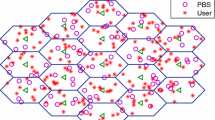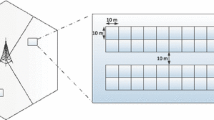Abstract
In this paper, we investigate the load balancing problem in mobile communications by considering sectorization and a hybrid F/CDMA scheme (HFCS) jointly in the scenario of uneven traffic distributions. The problem is formulated as a combinatorial optimization model, subject to quality of service (QoS) requirements, and solved by the Lagrangean relaxation approach. In addition, Lagrangean multipliers are used to conduct sensitivity analysis. The model’s objective is to minimize the weighted call blocking rate in terms of the distribution diversity. The model’s performance is evaluated by the proposed HFCS, which is an adaptive scheme (AS). We compare the performance of AS with that of a non-adaptive (NA) scheme, which is a common power control method. Experiment results show that combining sectorization with the bandwidth segmentation scheme provides effective adaptive load balancing (ALB). The performance improvement achieved by the proposed adaptive scheme over the common power control scheme is as high as 68%. Moreover, under the scheme, the performance improves as the traffic load increases. Load balancing improves even further when AS is combined with the sectorization.














Similar content being viewed by others
References
Wu, J.-S., Chung, J.-K., Sze, M.-T.: Analysis of uplink and downlink capacities for two-tier cellular system. IEE Proc. Commun. 144(6), 405–411 (1997). doi:10.1049/ip-com:19971648
Liberti, J.C., Rappaport, T.S.: Analytical results for capacity improvements in CDMA. IEEE Trans. Vehicular Technol. 43(3), 680–690 (1994). doi:10.1109/25.312781
Saraydar, C.U., Yener, A.: Adaptive cell sectorization for CDMA systems. IEEE J. Sel. Areas Comm. 19(6), 1041–1051 (2001). doi:10.1109/49.926360
Lee, C.Y., Kang, H.G., Park, T.: A dynamic sectorization of microcells for balanced traffic in CDMA: genetic algorithms approach. IEEE Trans. Vehicular Technol. 51(1), 63–72 (2002). doi:10.1109/25.992068
Hanly, S.V.: An algorithm for combined cell-site selection and power control to maximize cellular spread spectrum capacity. IEEE J. Sel. Areas Comm. 13(7), 1332–1340 (1995). doi:10.1109/49.414650
Takeo, K., Sato, S.: Evaluation of a CDMA cell design algorithm considering non-uniformity of traffic and base station locations. IEICE Trans. Fundam. Electron. Commun. Comput. Sci. E81-A(7), 1367–1377 (1998)
Houtao, Z., Buot, T., Nagaike, R., Harmen, S.: Load balancing in WCDMA systems by adjusting pilot power. Proc. IEEE WPMC 3, 936–940 (2002)
Tam, W.-M., Lau, F.C.M.: Analysis of power control and its imperfections in CDMA cellular systems. IEEE Trans. Vehicular Technol. 48(5), 1706–1717 (1999). doi:10.1109/25.790552
Chen, X.H., Lee, K.L.: A novel adaptive traffic load shedding scheme for CDMA celular mobile systems. Proc. IEEE ICCS 2, 566–570 (1994)
Chen, X.H.: Adaptive traffic-load shedding and its capacity gain in CDMA cellular mobile systems. IEE Proc. Commun. 142(3), 186–192 (1995). doi:10.1049/ip-com:19951913
Wang, Y.-T., Sheu, J.-P.: A dynamic channel-borrowing approach with fuzzy logic control in distributed cellular networks. Simul. Model. Pract. Theory 12(3–4), 287–303 (2004). doi:10.1016/j.simpat.2003.10.002
Ning, G., Zhu, G., Peng, L., Lu, X.: Research on hybrid dynamic load balancing algorithm in heterogeneous hierarchical wireless networks. J. Commun. 28(1), 75–81+86 (2007)
Sang, A., Wang, X., Madihian, M., Gitlin, R.D.: Coordinated load balancing, handoff/cell-site selection, and scheduling in multi-cell packet data systems. Wirel. Netw. 14(1), 103–120 (2008). doi:10.1007/s11276-006-8533-7
Eng, T., Milstein, L.B.: Comparison of hybrid FDMA/CDMA systems in frequency selective Rayleigh fading. IEEE J. Sel. Areas Comm. 12(5), 938–951 (1994). doi:10.1109/49.298068
Zhuge, L., Li, V.O.K.: Reverse-link capacity of multiband overlaid DS-CDMA systems. Mobile Netw. Appl. 7(2), 101–113 (2002). doi:10.1023/A:1013770704158
Zhuge, L., Li, V.O.K.: Overlaying CDMA systems with interference differentials. Mobile Netw. Appl. 8(3), 269–278 (2003). doi:10.1023/A:1023345815475
Kaufman, J.S.: Blocking in a shared resource environment. IEEE Trans. Commun. 29(10), 1474–1481 (1981). doi:10.1109/TCOM.1981.1094894
Chu, K.C., Lin, F.Y.S.: Survivability and performance optimization of mobile wireless communication networks in the event of base station failure. Comput. Electr. Eng. 32(1–3), 50–64 (2006). doi:10.1016/j.compeleceng.2006.01.015
Chu, K.C., Hung, L.P., Lin, F.Y.S.: Adaptive channel reservation for call admission control to support prioritized soft handoff calls in a cellular CDMA system. Ann. Telecommun. 64(11–12), 777–791 (2009). doi:10.1007/s12243-009-0126-x
Kim, D., Jeong, D.G.: Capacity unbalance between uplink and downlink in spectrally overlaid narrow-band and wide-band CDMA mobile systems. IEEE Trans. Vehicular Technol. 49(4), 1086–1093 (2000). doi:10.1109/25.875215
Jeon, W.S., Jeong, D.G.: Call admission control for mobile multimedia communications with traffic asymmetry between uplink and downlink. IEEE Trans. Vehicular Technol. 50(1), 59–66 (2001). doi:10.1109/25.917873
Jeon, W.S., Jeong, D.G.: Call admission control for CDMA mobile communications systems supporting multimedia services. IEEE Trans. Wirel. Comm. 1(4), 649–659 (2002). doi:10.1109/TWC.2002.804189
Chu, K.C., Lin, F.Y.S., Wang, C.-S.: An admission control-based benefit optimization model for mobile communications: the effect of a decision time budget. J. Network Systems Manage., forthcoming. doi:10.1007/s10922-009-9152-2
Kim, K., Han, Y.: A call admission control scheme for multi-rate traffic based on total received power. IEICE Trans. Commun. E84-B(3), 457–463 (2001)
Acknowledgments
This paper was awarded the Dragon Thesis Award, Gold Medal, by the Acer Foundation in 2005.
Author information
Authors and Affiliations
Corresponding author
Rights and permissions
About this article
Cite this article
Chu, KC., Lin, F.YS. & Wang, CS. Modeling of Adaptive Load Balancing with Hybrid F/CDMA and Sectorization Schemes in Mobile Communication Networks. J Netw Syst Manage 18, 395–417 (2010). https://doi.org/10.1007/s10922-009-9149-x
Published:
Issue Date:
DOI: https://doi.org/10.1007/s10922-009-9149-x




